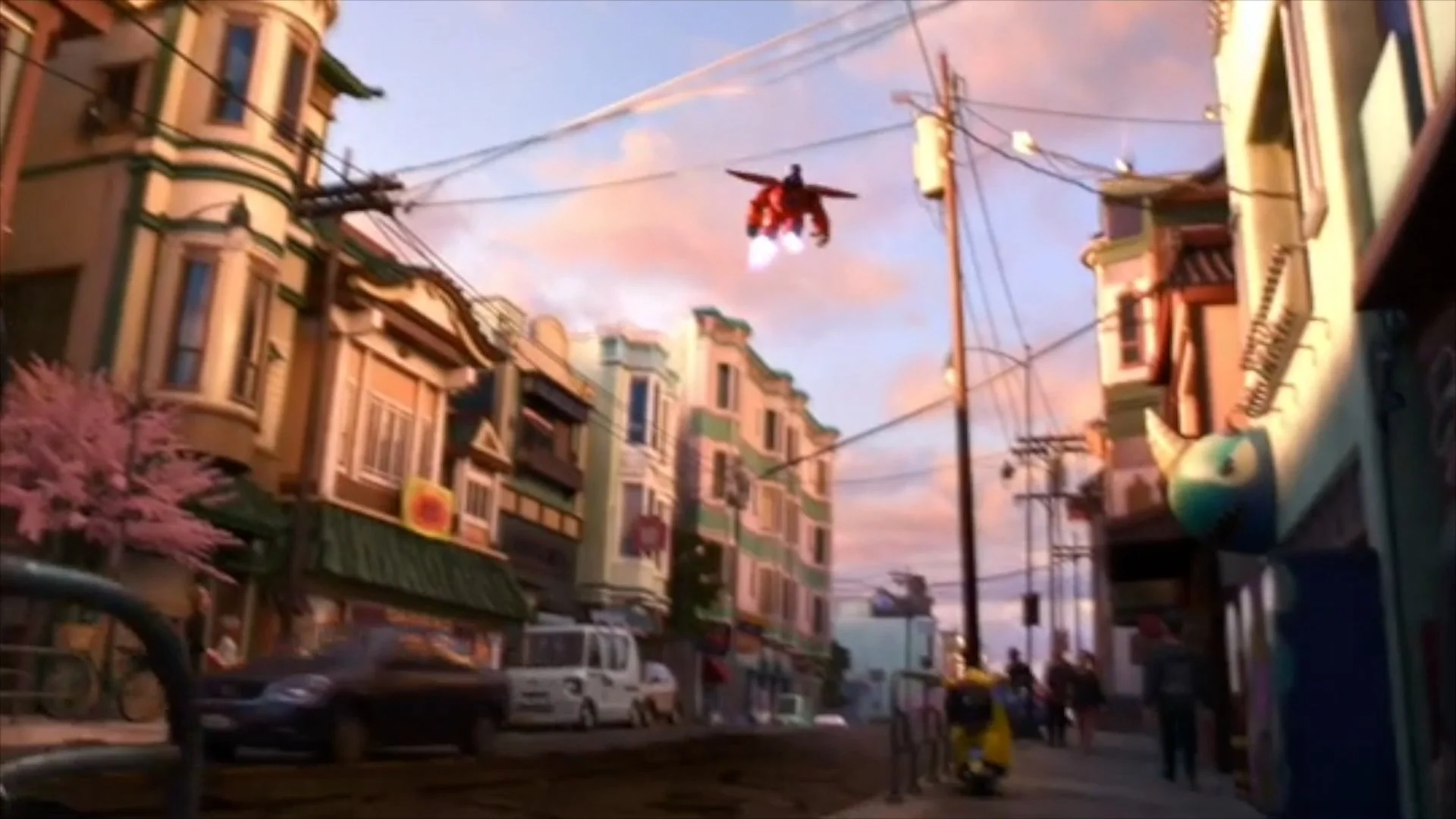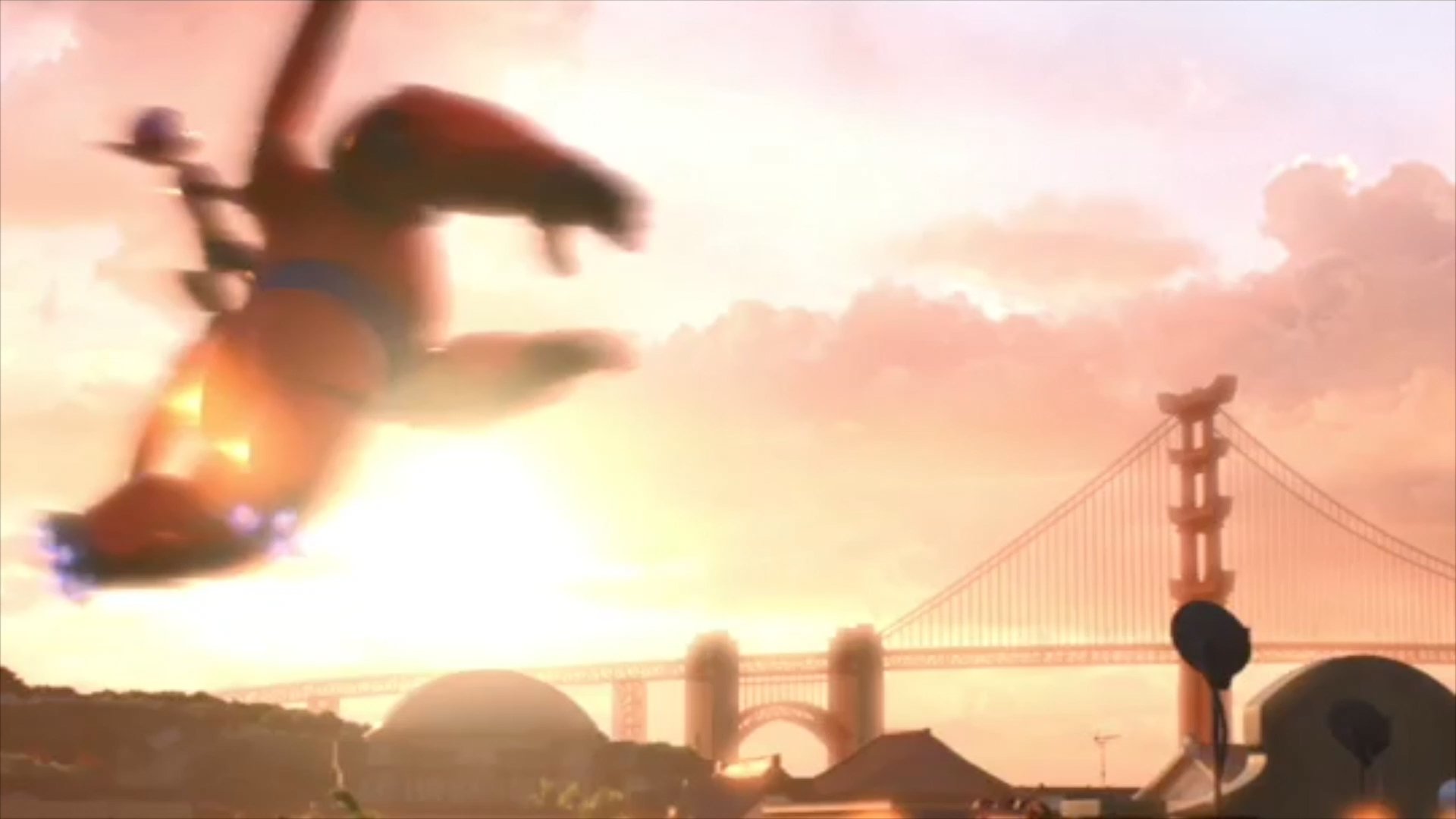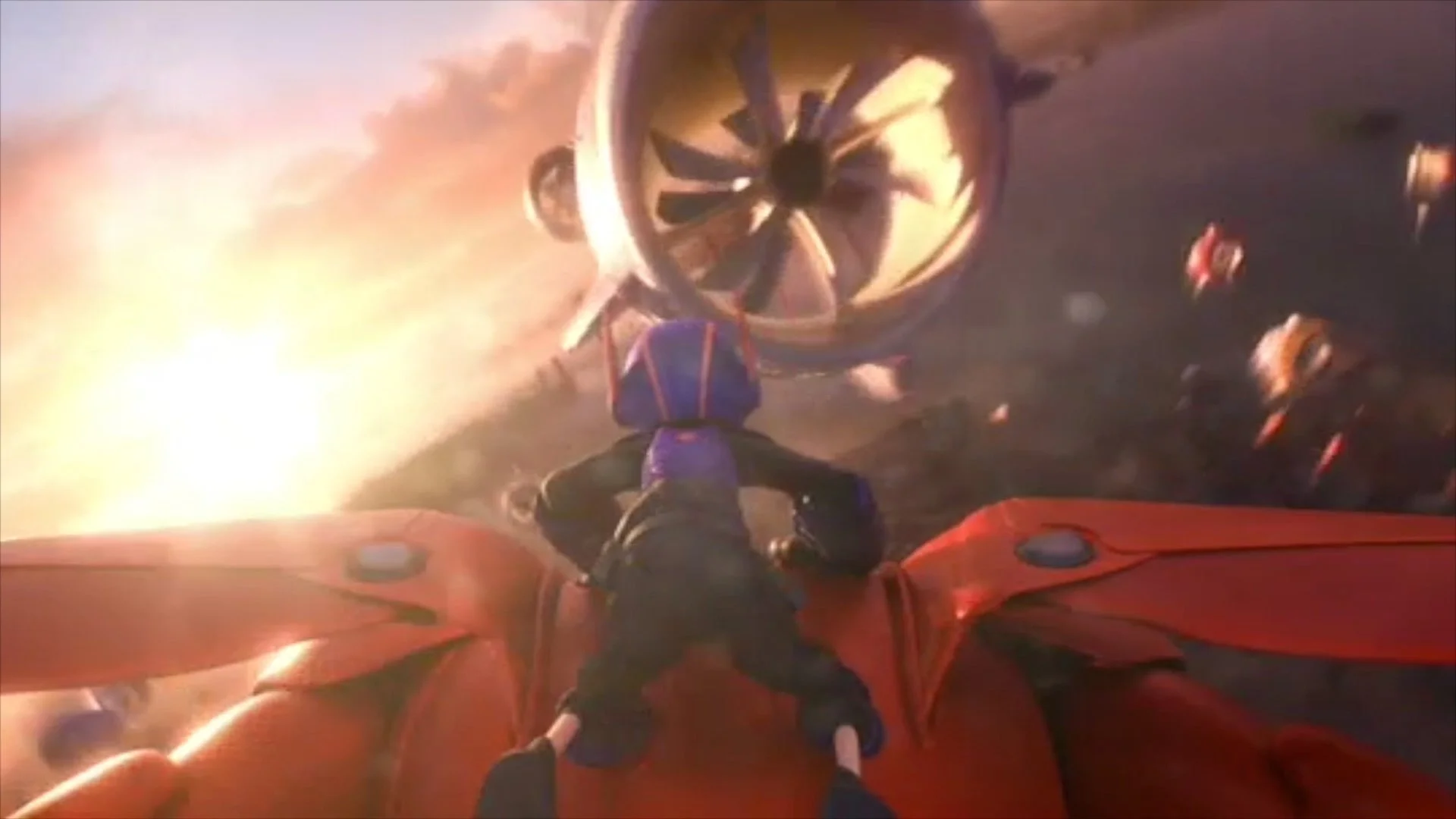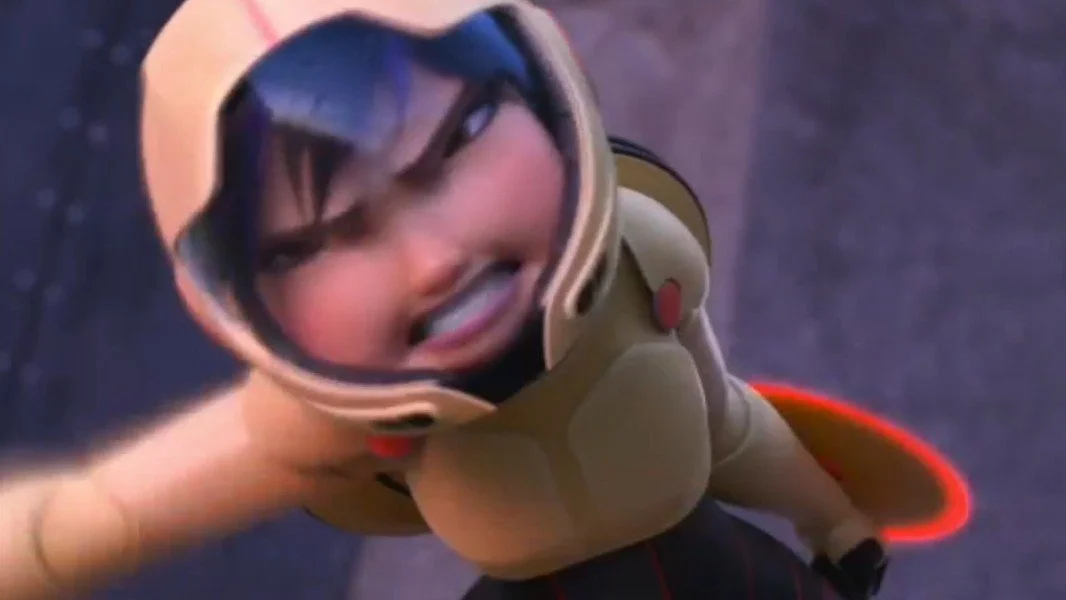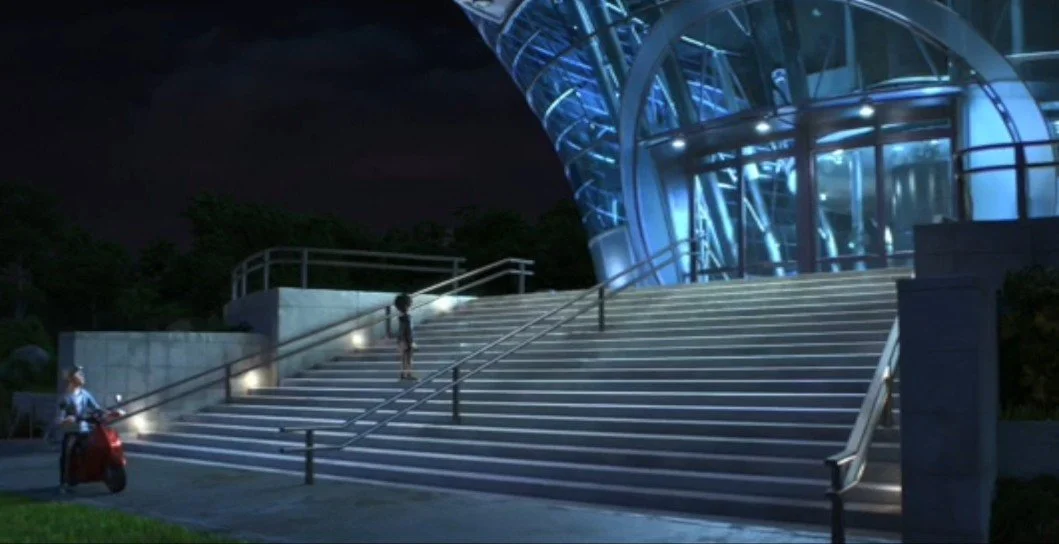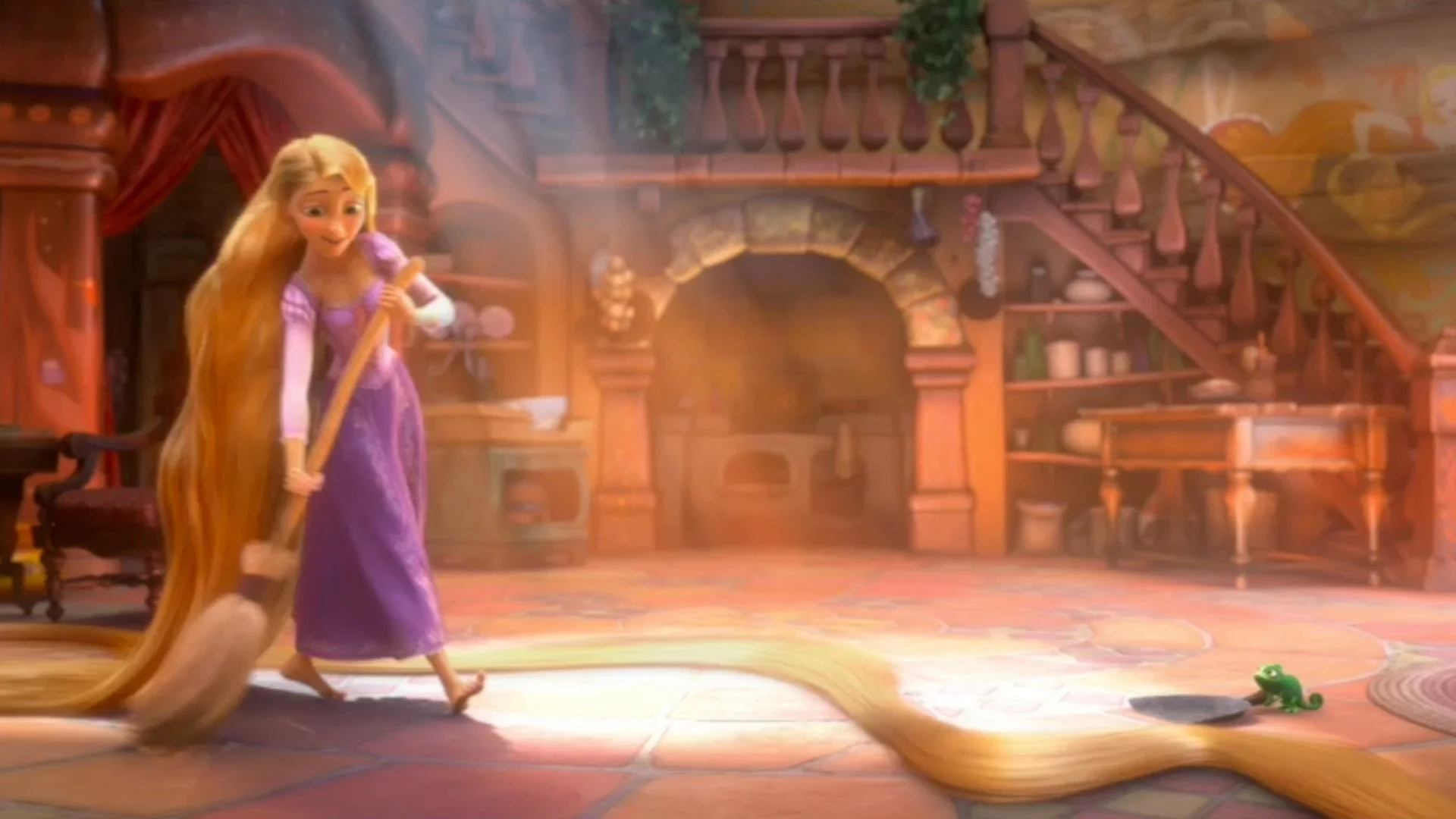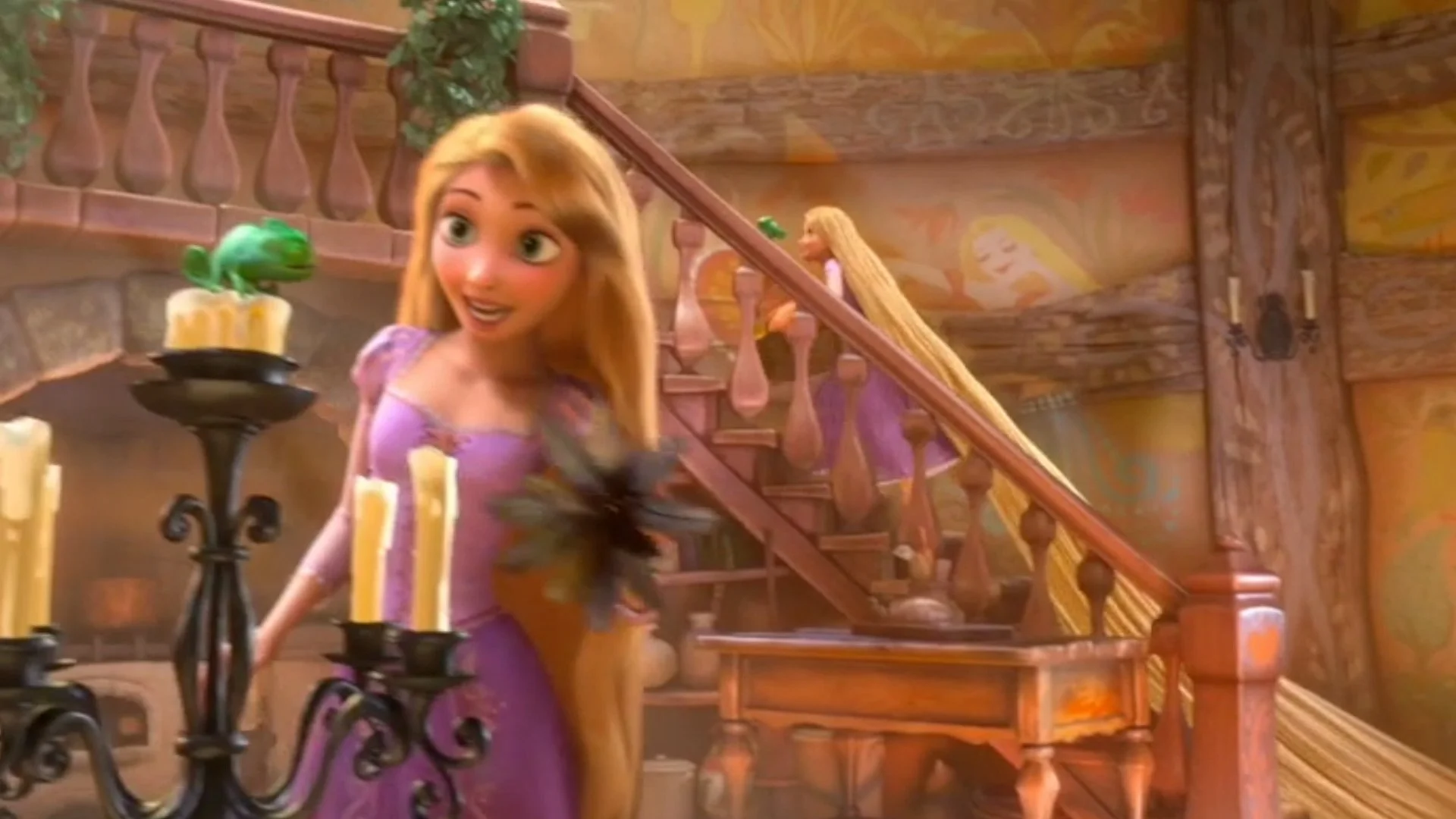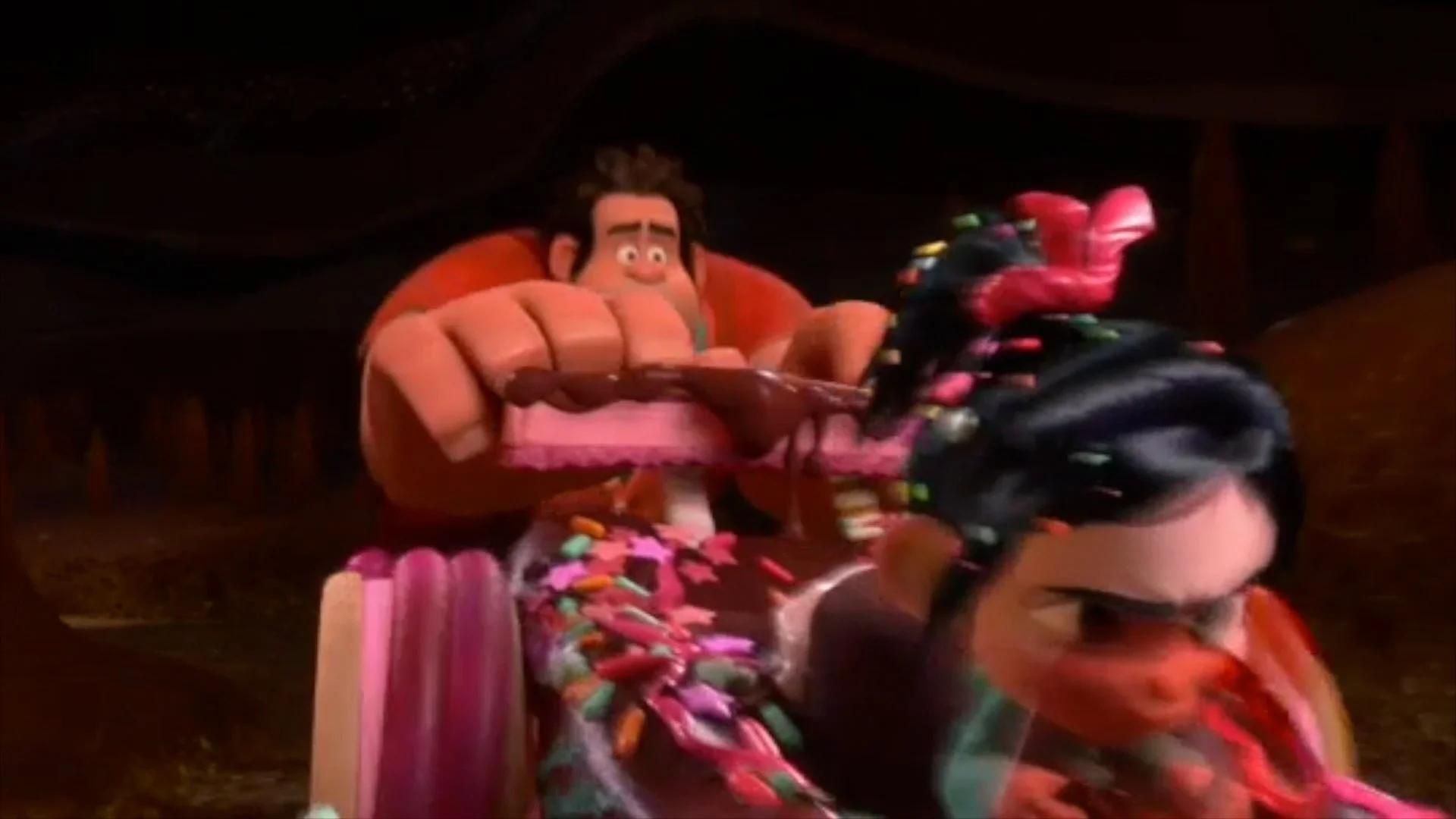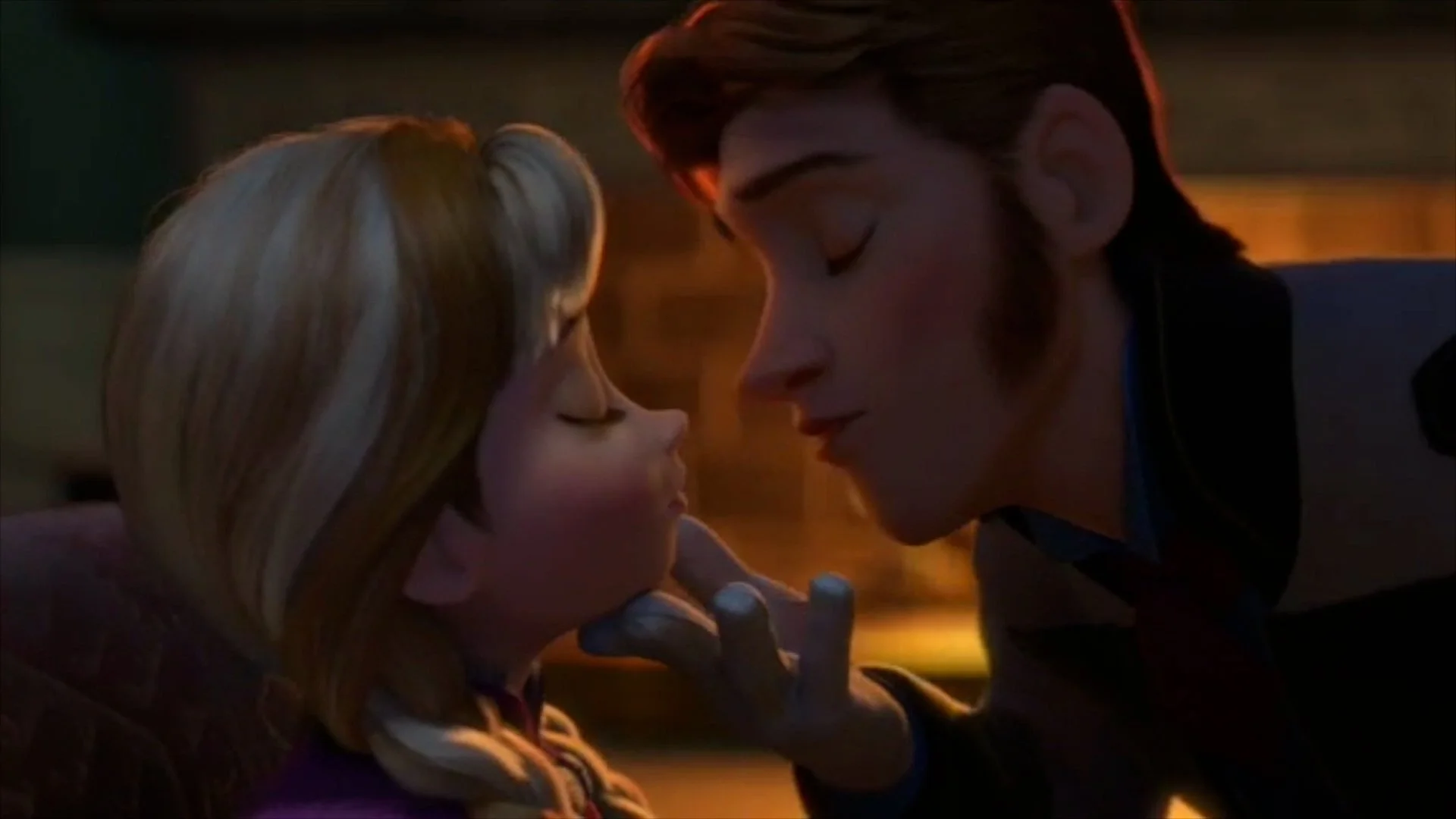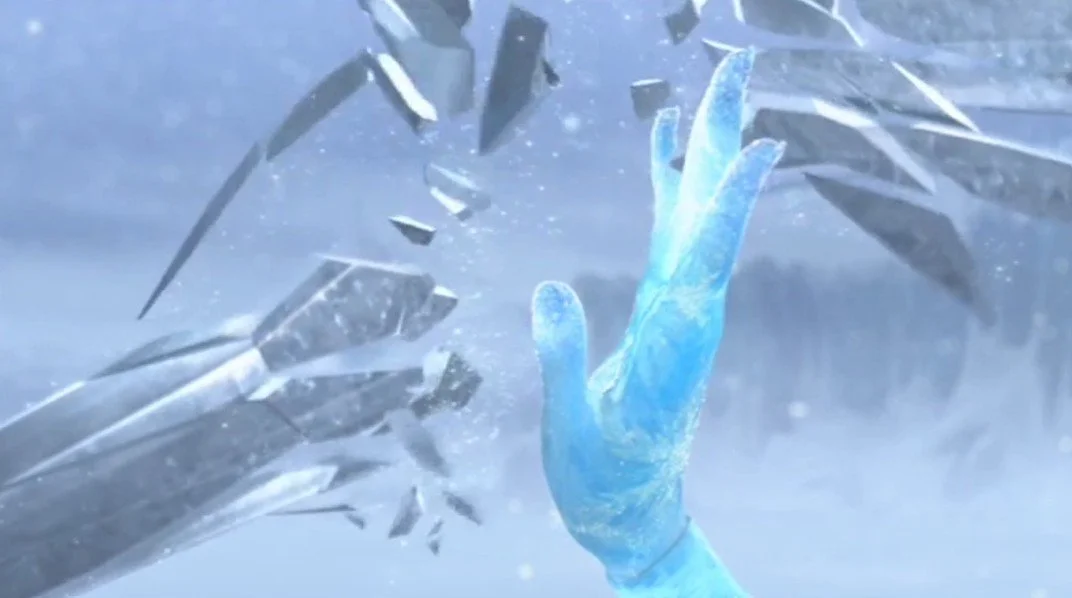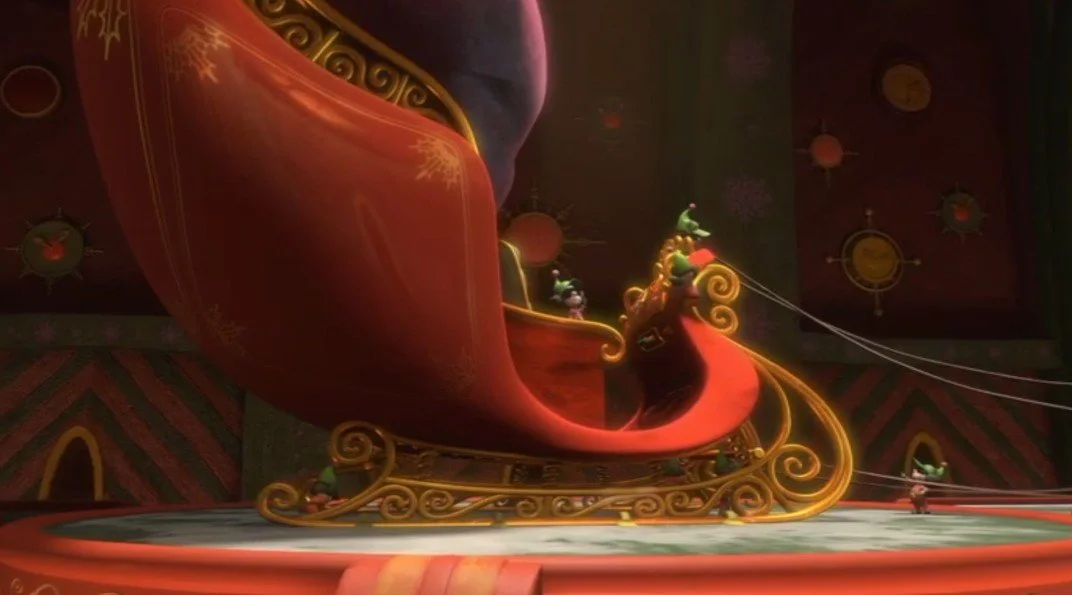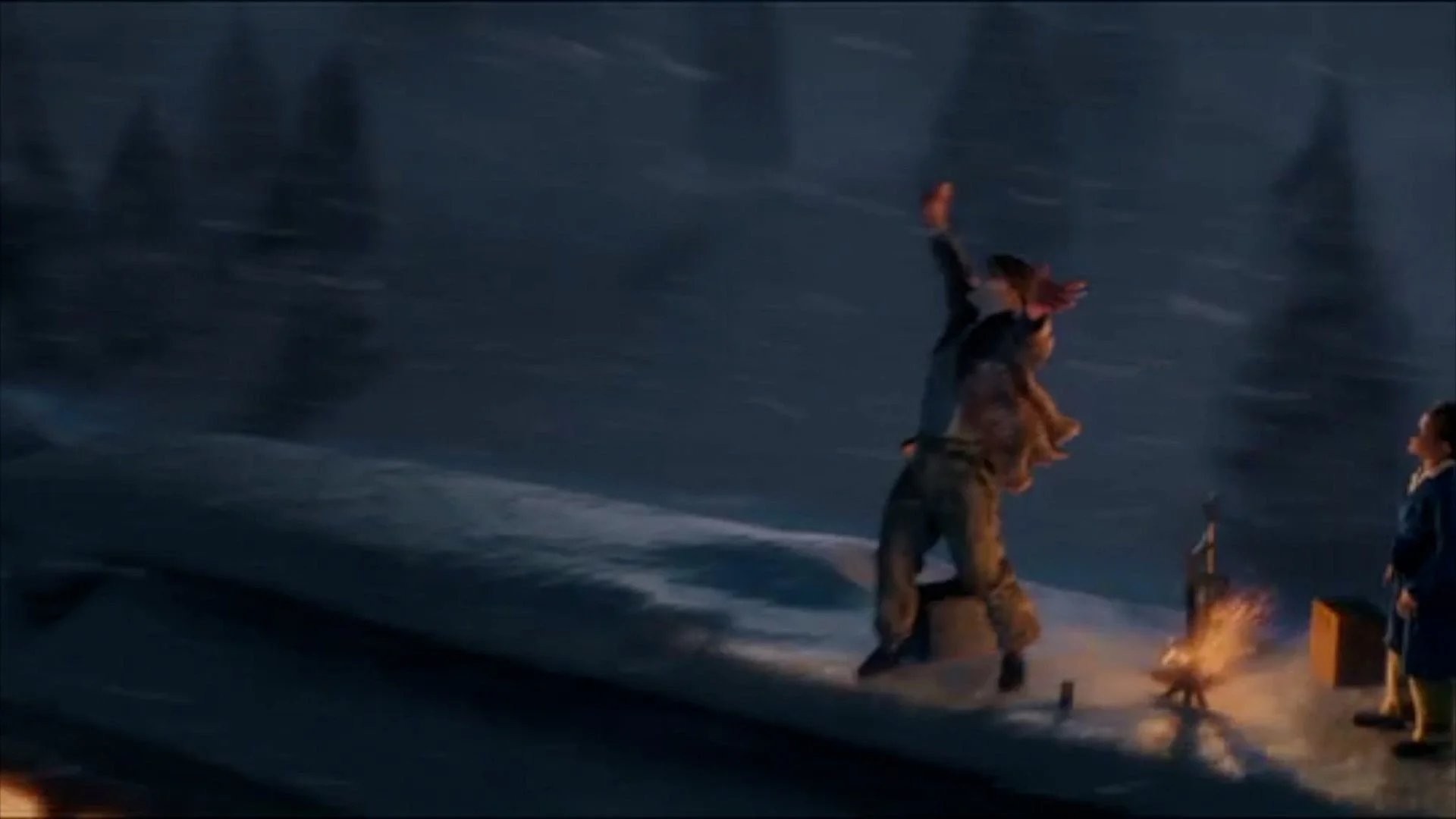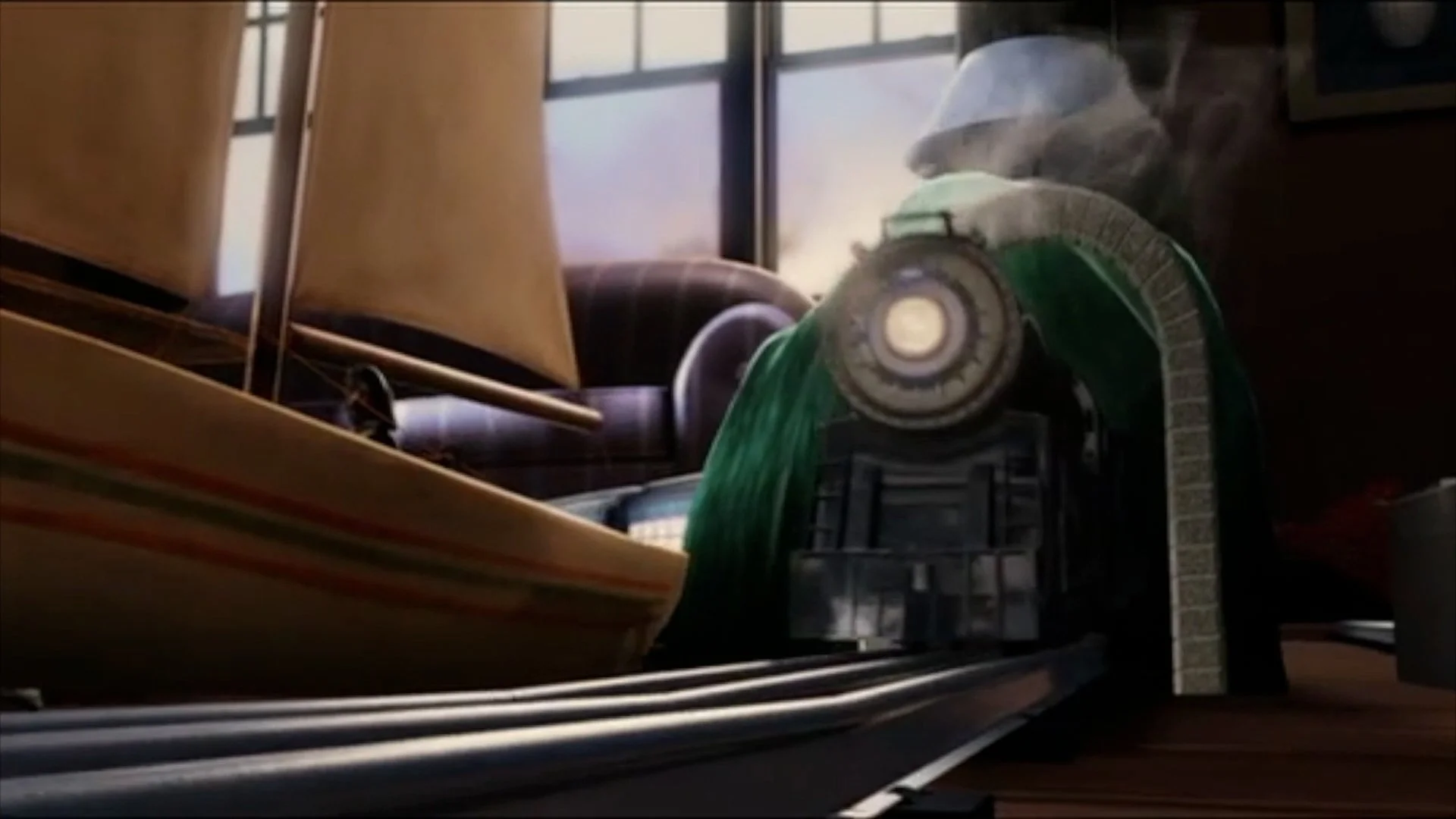Breakdown: Feature Animation
Lighting and Compositing for Walt Disney Feature Animation and Sony Imageworks.
Disney – Big Hero 6 Runtime: 0:06–0:10
Shot: Baymax and Hiro Flyover Role: Lighting & Compositing Artist
Lit using Disney’s proprietary Hyperion renderer via the Delight interface; composited in Nuke. Developed a custom lighting rig for a stylized mid-morning look, emphasizing cool shadows and warm glints across building facades. Grouped lighting sources into Sky, Key, and Fill categories for precise adjustment and relighting control. Rendered out full AOVs—diffuse, specular, reflections, shadows, and FX passes—enabling nuanced comp-level tuning. Integrated Baymax’s jetboot FX, and projected a high-resolution matte-painted sky onto a large sphere geometry to enhance depth and cohesion. Balanced sunlight and ambient occlusion to preserve mood and character readability within a dense urban environment.
Disney – Big Hero 6 Runtime: 0:10–0:13
Shot: Baymax and Hiro – Quick Pan and Tilt Up Role: Lighting & Compositing Artist
Lit using Disney’s proprietary Hyperion renderer via the Delight interface; composited in Nuke. This transitional pickup shot continues the flyover sequence with a fast upward pan, requiring precise FX integration and lighting continuity. Matched lighting rigs to the previous street-level shot but adjusted the key-to-fill ratio for the elevated altitude and clearer sky. Integrated provided FX elements—Baymax’s jet boot flames and the trailing smoke plume—reinforcing momentum through directional lighting and soft-edge compositing. Applied a show-standard in-comp lens flare for dynamic realism, tuned specifically for the quick tilt motion. Added interactive lighting from the jet jets to subtly strike and animate the oversized cat statue below, anchoring the viewer’s eye and maintaining narrative clarity in a fast, high-action moment.
Disney – Big Hero 6 Runtime: 0:13–0:16
Shot: Baymax and Hiro – Fly Through Hovering Turbines Role: Lighting & Compositing Artist
Lit in Hyperion via the Delight interface; composited in Nuke. This over-the-shoulder shot tracks Baymax and Hiro flying through a high-altitude turbine field above the city. Built lighting to align with pre-approved color keys, emphasizing motion and continuity with prior shots. Maintained a higher key-to-fill ratio appropriate for altitude and time of day, adding warm morning sunlight to rim the sky turbines and reflect across their metallic surfaces. Created sweet, animated specular highlights that swept across characters and elements to enhance momentum. Used depth mattes and Z-pass elements to finesse fog layering and atmospheric falloff across the expansive cityscape and distant mountains—reinforcing scale and cinematic depth during this fast-paced sequence.
Disney – Big Hero 6 Runtime: 0:16–0:18
Shot: Flight to Mission Location Role: Lighting & Compositing Artist
Lit with Hyperion via the Delight interface and composited in Nuke. This medium ¾ shot shows the team flying toward their mission objective, set against a glowing late-day sky. I reduced the key-to-fill ratio to emphasize form without flattening depth, crafting a more directional golden-hour sunlight with soft, elongated shadows. The look evokes the calm before action—focused, cinematic, and emotionally charged. Used grouped light controls (sky, key, fill) for subtle mood adjustments and built in-comp gradients and soft falloff to maintain continuity across the sequence.
Disney – Big Hero 6 Runtime: 0:19–0:21
Shot: Wasabi – Close-Up at No Trespassing Sign Role: Lighting & Compositing Artist
Lit with Disney’s proprietary Hyperion renderer via the Delight interface and composited in Nuke. This close-up features Wasabi reacting to a "No Trespassing" sign just after sunset. I crafted a soft rim light from screen right to gently define his silhouette and facial features without overpowering the naturalistic tone. The lighting captures the tail end of dusk—cooler ambient values with a hint of directional falloff—enhancing the emotional nuance without losing clarity. Depth mattes were used to subtly separate the character from the background foliage and signage. Adjustments were made in-comp to refine specular highlights and preserve focus on Wasabi’s gesture and expression.
Disney – Big Hero 6 Runtime: 0:21–0:24
Shot: Hiro and the Gang of Six – Reaction to Fear Role: Lighting & Compositing Artist
Rendered with Hyperion and composited in Nuke. This ensemble shot features the full team stepping into frame and reacting with visible fear. Maintaining continuity with the fallen golden hour look of the previous scenes, I employed soft backlighting to silhouette each character while using subtle, controlled fill to preserve facial readability. This approach created an emotional contrast—leveraging the lingering warmth of sunset lighting against the cold, narrative tension of the scene. Used depth mattes to stage atmospheric separation between the team and background elements, enhancing depth and maintaining visual focus on the characters' expressions and physical reactions.
Disney – Big Hero 6 Runtime: 0:25–0:27
Shot: Close-Ups – Honey Lemon, Go Go, Wasabi, and Fred Role: Lighting & Compositing Artist
Rendered using Disney’s proprietary Hyperion renderer and composited in Nuke. This sequence of close-up shots features each gang member launching frantic attacks against an off-screen threat. I incorporated strong interactive lighting from Wasabi’s plasma blades and Fred’s fire breath to dynamically illuminate the characters’ faces and surrounding elements. These FX-driven light sources were composited to pulse and flicker believably, synchronized to action beats. I balanced the dramatic glow with the residual golden hour lighting from previous shots—maintaining tonal consistency while pushing contrast and urgency. Depth mattes and rim keys were used to separate figures from the background and amplify the chaotic energy of the scene.
Disney – Big Hero 6 Runtime: 0:27–0:30
Shot: Medium Shot – Punchline Reveal of the Horror Role: Lighting & Compositing Artist
Utilized Disney’s Hyperion renderer and composited in Nuke. This comedic beat concludes the tension built in the prior action shots, revealing only a harmless pigeon amid a soot-marked patch of concrete and a wisp of smoke. I lit the shot to maintain consistency with the preceding fallen golden hour setup, using soft, warm lighting to balance the humor with cinematic tone. Smoke FX were integrated and composited with subtle opacity shifts to evoke the characters' mistaken intensity, and I built up the soot and ground damage in comp for faster iterations and customizations.
Disney – Big Hero 6 Runtime: 0:30–0:43
Shot: Medium-Long Shot – Wasabi Breaches the Vault Role: Lighting & Compositing Artist
Utilized Disney’s Hyperion renderer and composited in Nuke. This shot was a close collaboration between lighting and FX to define the look of molten metal, heat distortion, and flying embers as Wasabi cuts through the vault. I created the interactive lighting by parenting the plasma blade geometry to emission surfaces, which drove dynamic light spill across the metal doors and surrounding environment and FX smoke. Careful attention was given to the material response, crafting a heat decay from white-hot plasma to cooling red embers, to ground the visual storytelling in physical believability. These elements came together in comp, where I dialed in the balance of light, haze, and reflection to support the shot’s cinematic tension and final team reveal.
Disney – Big Hero 6 Runtime: 0:44–0:55
Shot: Sequence – Technology Building Arrival Role: Lighting & Compositing Artist
Utilized Disney’s Hyperion renderer and composited in Nuke. This sequence includes Tadashi arriving on his scooter and a wide shot of Hiro facing the entrance of the technology institute. I lit the key shots in this location, focusing on making the building’s glass façade feel like a jewel, with diamond-like specular highlights, reflections, and soft internal refractions. The building itself became a subtle light source, with pools of light spilling out from lost-and-found moments within the structure, adding interest across the nearby campus grounds. Careful balance was required to ensure the building’s luminosity and complexity didn’t compete with the dramatic key lighting on Hiro.
Disney – Tangled Runtime: 0:56–0:59
Shot: Rapunzel Starting Her Day Role: Key Lighting & Compositing Artist
Rendered in RenderMan using a scanline pipeline and composited in Shake. This shot is part of the upbeat opening sequence, where Rapunzel begins her day inside the tower. It was the closest I came to a painterly look in my lighting work — approaching the shot as if painting on canvas, using light and shadow to guide the viewer’s eye with deliberate visual rhythm. I key lit the early morning interior with soft pools of directional light, suggesting warm sunlight filtering through high, offscreen windows. These beams created stage-like patches across the floor and set, helping define space and motion without pulling focus from character performance. I maintained a medium key-to-fill ratio, keeping contrast low and softness high across skin and fabric to preserve the film’s aesthetic.
Disney – Tangled
Runtime: 1:00–1:02
Shot: Rapunzel Sweeps the Floor with Pascal
Role: Key Lighting & Compositing Artist
Rendered in RenderMan and composited in Shake. This was the key lighting shot for the sequence — a foundational setup from which other shots were propagated and then refined. I lit and composited this moment, where Rapunzel sweeps dust into a pile as Pascal waits with a dustbin. I designed the lighting to feel overly cheerful and radiant, setting up an emotional contrast with the reality of her confinement — a bright facade over a lonely truth.
I sculpted shafts of warm sunlight to pool in the center of the floor, using back and rim lighting to give Rapunzel a soft, almost glowing edge. In comp, I faded the beams before they reached her directly, ensuring they framed her without contaminating her key lighting. I added a slight bloom to the floor to enhance the warmth and help it feel sunlit and textured, while subtle bounce from the lit floor up onto the vertical surfaces helped integrate the space. Cool-toned shadows were used to let the warm key stand out, giving the image a vibrant, painterly quality while guiding the viewer’s eye.
Disney – Tangled Runtime: 1:00–1:04
Shot: Close-up of Pascal – Opening Song Role: Lighting & Compositing Artist
Rendered in RenderMan and composited in Shake. I lit and composited this comedic close-up to match the warm, painterly tone of the tower interior. I pitched the idea of obscuring everything in dust except for Pascal’s blinking eyes to strengthen the gag’s visual punch — an idea that was approved by leadership and carried through to final. I developed a custom RenderMan shader to achieve Pascal’s dusty appearance and executed a clean-to-dust-covered wipe in comp to enhance comedic timing and support the playful interaction with Rapunzel.
Disney – Tangled Runtime: 1:05–1:13
Shot: Opening Song – Multi-Sequence Dissolve Role: Lighting & Compositing Artist
Rendered in RenderMan and composited in Shake. This technically complex shot required coordinating multiple dissolving sequences within a single shot—a workflow the pipeline wasn’t originally designed to support. I collaborated closely with the pipeline team to enable seamless ingestion and maintain lighting continuity across the dissolves.
Artistically, one section featured soaping mop water reflecting the characters and the interior surfaces of the room. I intentionally crafted the soap bubbles with distinct specular highlights to emphasize their delicate surfaces. Additionally, I designed special rim lighting on Pascal to make his small form visually pop while still integrating naturally with the room’s overall lighting. Depth cues, rim lighting, and contrast were carefully balanced to keep Rapunzel and Pascal clearly readable against a moderately complex background, preserving narrative focus throughout the transitions.
Disney – Tangled Runtime: 1:13–1:14
Shot: Rapunzel’s Toe Touches Role: Key Lighting & Compositing Artist
Rendered in RenderMan and composited in Shake. In this brief moment of Rapunzel performing toe touches, I added a soft rim light sourced from the off-screen window to accentuate her motion and maintain the light, airy mood of the sequence. This rim served both an aesthetic and narrative function—gently guiding the viewer’s eye without breaking from the warm, painterly lighting style established in earlier shots. The lighting was designed to feel natural, while still providing subtle structure and visual clarity to the movement.
Disney – Tangled Runtime: 1:15–1:38
Shot: Sequence – Pathway to the Snuggly Duckling Role: Key Lighting & Compositing Artist
Rendered in RenderMan and composited in Shake. This sequence follows Rapunzel and Flynn through the wooded path leading to the Snuggly Duckling inn. Building on the color keys from the art department, I approached the lighting with a painterly mindset—using light as a compositional tool to guide the viewer’s eye through the frame. I layered in dappled sunlight across characters and environment, complemented by shafts of directional light to create depth, shape, and atmosphere. These choices added richness to the forest setting and a cinematic feel that grounded the characters within their world while subtly foreshadowing the shift in tone to come.
Disney – Tangled Runtime: 1:39–1:56
Shot: Sequence – Exterior of the Snuggly Duckling Role: Key Lighting & Compositing Artist
Rendered in RenderMan and composited in Shake. For this sequence outside the Snuggly Duckling, I developed a versatile lighting rig tailored for Mother Gothel, designed to balance subtle villainy with visual appeal. I explored lighting approaches that enhanced her complexity while maintaining strong contrast and tonal control. The challenge was to guide the viewer's attention between interior action and her reactions at the doorway, ensuring smooth narrative continuity. I also key lit both Mother Gothel and Shorty, establishing a clean, reusable lighting setup that supported handoff to other artists and maintained consistency across the sequence.
Disney – Bolt Runtime: 1:57–2:13
Shot: Penny Chase Sequence Role: Key Lighting & Compositing Artist
Rendered in RenderMan and composited in Shake. I lit and composited this high-energy sequence of Penny being pursued by electro-gloved villains. The visual style was heavily influenced by Edward Hopper and American Realism, with a painterly aesthetic that emphasized light, depth, and saturation. I carefully shaped shadow tones and midtones to retain richness while allowing the backgrounds to fall into soft atmospheric fades. Selective blooming was applied to highlights and environmental elements to reinforce the cinematic, Hopper-inspired lighting design.
In addition to environment lighting, I built custom rigs for Penny to integrate interactive light from electro-glove charges and explosion FX, enhancing both realism and narrative readability.
The shot of Penny’s scooter emerging into frame with a line of helicopters overhead (RT 2:12) received direct praise from Executive Producer John Lasseter, who requested the shot be extended in duration to give it more prominence.
Disney – Wreck-It Ralph
Runtime: 2:15–2:19
Shot: Ralph Teaching Vanellope to Drive
Role: Lighting & Compositing Artist
Rendered in RenderMan and composited in Shake. This montage features Ralph coaching Vanellope through the basics of driving her candy go-kart along the stylized, whimsical racetrack. I lit and composited these shots using a "lost and found" lighting approach—employing gobo spotlights to break up the interior space with dynamic pools of light, enhancing the sense of speed, scale, and rhythm throughout the sequence.
I paid particular attention to material response, referencing real-world candy to ensure the kart and environment felt tactile and appetizing. My dialed-in candy surface materials were well received by show leadership and reused by peer artists across the sequence to elevate the overall visual richness. In the comedic beat where Vanellope spits out her tooth, I crafted a subtle spotlight to draw focus without disrupting the sequence’s visual rhythm—ensuring the gag landed clearly while maintaining the playful tone of the world.
Disney – Wreck-It Ralph
Runtime: 2:19–2:41
Shots: King Candy Throne Room and Candy Landscape
Role: Lighting & Compositing Artist
Rendered in RenderMan and composited in Nuke. This sequence includes a range of shots featuring King Candy, both inside his ornate throne room and out in the surrounding candy landscape. I lit and composited the shots, designing the throne room with long, stylized shadows to heighten the theatrical tone of the space. For King Candy, I gave special attention to material response—handling the satin sheen of his bow tie and the wafer-thin translucency of his collar with care. The final lighting look for King Candy was so well received that the rig I developed was reused across multiple sequences. Its flexibility and clarity made it easy for peers to ingest and adapt, ensuring consistent character presentation throughout the film and streamlining shot production for the broader team.
For the comedic beat at RT 2:35, I built a tracking comp gag to exaggerate the magnification of King Candy’s eyes through his glasses. This gave us precise control over eye size scale and position, ensuring the moment landed with the intended comedic punch while staying visually integrated.
Disney – Frozen (Oscar Winner – Best Animated Feature) Runtime: 2:42–2:51
Shot: Anna Meets the Forest Trolls Role: Lighting & Compositing Artist
Rendered in RenderMan and composited in Nuke. This enchanting sequence introduces Anna to the Forest Trolls, blending warmth and wonder with a magical tone. I lit and composited these shots with a focus on atmosphere and fantasy realism. A key visual element was the trolls’ glowing jewel necklaces—designed with interactive lighting and layered glows in comp to enhance their mystical qualities without overpowering the emotional beat. These subtle treatments supported the magical world-building while keeping the character moments grounded and visually cohesive.
Disney – Frozen (Oscar Winner – Best Animated Feature) Runtime: 2:51–3:09
Shot: Hans Reveals His True Nature to Anna Role: Lighting & Compositing Artist
Rendered in RenderMan and composited in Nuke. This pivotal emotional scene required a subtle and intentional lighting approach. I key lit and composited the sequence with a focus on warm, flickering fireplace illumination, shaping soft rim lighting around the characters to gently isolate them against the darker room. The contrast between the firelight and the cool, moonlit shadows helped underscore the emotional shift—Anna’s vulnerability against Hans’s betrayal. I used the fireplace as both a visual and symbolic anchor, designing the lighting to support the dramatic tension without overpowering the performances, maintaining clarity and mood through restrained, cinematic choices.
Disney – Frozen (Oscar Winner – Best Animated Feature) Runtime: 3:10–3:17
Shot: Anna’s Sacrificial Freeze Role: Lighting & Compositing Artist
Rendered in RenderMan and composited in Nuke. This emotionally charged moment—Anna’s slow-motion transformation into ice as she intercepts Hans’s blade—was one of the most technically intricate shots I contributed to. Though the sequence appears deceptively simple, it required the integration of multiple passes, including reflections, subsurface scattering, and subtle refraction, to convincingly convey the frozen transformation. Special attention was given to maintaining Anna’s expressive silhouette in her final frozen pose, ensuring the shot captured both the tragedy and heroism of the moment while making the audience truly believe in her sacrifice.
Prep & Landing — Sleigh Reveal and Sled Launch
Runtime: 3:17–3:25
Role: Lighting & Compositing Artist
Rendered in RenderMan and composited in Nuke. In this festive sequence from the CBS/Disney Christmas special Prep & Landing, I carefully timed the interactive lighting to enhance the dramatic reveal of Santa’s sleigh, collaborating closely with the FX team to ensure the bloom and glow from the surrounding smoke integrated seamlessly and maintained a cinematic quality. A particular point of pride was the lighting and shading treatment of Santa’s iconic red sleigh—I focused on achieving the perfect balance of reflections and subsurface warmth to preserve its rich “cherry red” look under varying lighting conditions. This work was highly praised by artistic leadership, and my material setups were adopted by fellow artists across the production to ensure consistent quality and visual continuity.
Sony Imageworks – The Polar Express Runtime: 3:25–3:30
Shot: Hobo Campfire Sequence Role: Team Lead Lighter & Compositor
Rendered in RenderMan and composited using Sony Imageworks’ proprietary compositing tools. As Lighting Lead, I was responsible not only for designing and compositing my own shots but also for guiding a team of eight lighters and compositors to achieve the lighting look and aesthetic across the sequence. I acted as the primary troubleshooter for technical and process-related challenges, ensuring smooth workflow and maintaining visual consistency.
For this intimate Hobo campfire moment, I developed a dynamic lighting rig with multiple states to support the evolving story beats, carefully balancing warmth and mystery. This shot exemplifies how precise lighting can direct the viewer’s attention to the subtle nuances of the performance capture, blending technical accuracy with emotional depth.
Sony Imageworks – The Polar Express Runtime: 3:30–3:41
Shot: “Christmas Morning” Sequence Role: Lead Lighting & Compositing Artist
Rendered in RenderMan and composited using Sony Imageworks’ proprietary tools. For the emotional finale of The Polar Express, I led the lighting and compositing efforts on the “Christmas Morning” sequence, starting with the iconic close-up of the toy train. Working before global illumination was standard in production pipelines, I developed an innovative solution to create dynamic, traveling reflections on the train’s metal surfaces by parenting six cameras to the animated train to capture multiple reflection angles. This technique added richness and depth to the visuals, enhancing the magical atmosphere of this climactic moment and demonstrating creative problem-solving in a technically challenging environment.
Prep & Landing — End Shot
Runtime: 3:42–3:45
Role: Lead Lighter & Compositor
Rendered in RenderMan and composited in Shake. For the warm closing shot of Prep & Landing, I lit and composited the charming moment of Lanny opening his Christmas gift of fruitcake. This fast-paced, highly collaborative production demanded an exceptional output, with our team completing roughly 10 shots per week. To meet this ambitious schedule, I championed a “no-versioning” workflow where creative leads committed to forward-only notes, enabling uninterrupted progress without time-consuming backtracking. We also leveraged a newly developed pipeline that empowered artists like myself to efficiently adjust upstream assets and work with flexibility.
Balancing speed with quality, I personally maintained a weekly output of approximately 12 shots—well above the industry norm of 2–3 shots per week—while ensuring artistic consistency and high visual standards.
